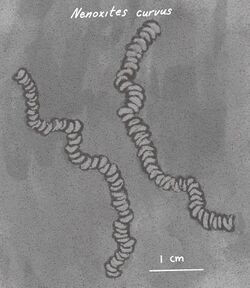Earth:Nenoxites
| Nenoxites | |
|---|---|

| |
| Paleoart rendition of Nenoxites curvus fossils with 1 cm scale bar. | |
| Trace fossil classification|Trace fossil classification | |
| Ichnogenus: | †Nenoxites Fedonkin, 1973 |
| Ichnospecies | |
| |
Nenoxites is an extinct genus of Ediacaran ichnofossils described by Mikhail Fedonkin in 1973. The genus is monotypic; the only species to have been described is Nenoxites curvus.[1]
Description
Nenoxites is a repichnia trace of soft-bodied bilaterians, similar to a modern day shell-less gastropod. The traces are hypothesized to have been created via locomotive peristalsis, a wave-like constriction and relaxation of muscle resulting in the sinouous pattern and irregular depressions of the fossil.[2][1] Nenoxites ichnofossils are thought to be the earliest instance of precambrian bioturbation, a behavior wherein an organism disturbs substrate to find food. The common interpretation of the morphology of Nenoxites is comparable to traces of contemporary gastropods, and is thought to have been made by the earliest tripoblastic eumetazoans, though there is no current agreed upon taxonomy or biology of Nenoxites.[1][3]
Instances of Nenoxites have been recorded in the Khatyspyt Formation in arctic Siberia, as well as in Russia and China.[3]
Some scientists disagree with the popular interpretation of Nenoxites as a trace fossil, and instead interpret it as a body fossil.[4] Some interpret it as a mycetozoan, due to the irregularity in its size.[5]
References
- ↑ 1.0 1.1 1.2 Fedonkin, Mikhail (1983). Upper Precambrian and Cambrian Paleontology of the East-European Platform. Publishing House Widawnictwa Geologiczne Warshwa. ISBN 83-220-0138-X.
- ↑ Dmitriy Grazhdankin (1 March 2014). "Patterns of Evolution of the Ediacaran Soft-Bodied Biota". Journal of Paleontology 88 (2): 269–283. doi:10.1666/13-072. https://bioone.org/journals/journal-of-paleontology/volume-88/issue-2/13-072/Patterns-of-Evolution-of-the-Ediacaran-Soft-Bodied-Biota/10.1666/13-072.full. Retrieved 18 November 2021.
- ↑ 3.0 3.1 Vladimir Rogov, Vasiliy Marusin, Natalia Bykova, Yuriy Goy, Konstantin Nagovitsin, Boris Kochnev, Galina Karlova, Dmitriy Grazhdankin (2012). "The oldest evidence of bioturbation on Earth". Geology 40 (5): 395–398. doi:10.1130/G32807.1. Bibcode: 2012Geo....40..395R. https://pubs.geoscienceworld.org/gsa/geology/article/40/5/395/130862/The-oldest-evidence-of-bioturbation-on-Earth. Retrieved 18 November 2021.
- ↑ Cui Luo, Lanyun Miao (1 May 2020). "A Horodyskia-Nenoxites-dominated fossil assemblage from the Ediacaran-Cambrian transition (Liuchapo Formation, Hunan Province): Its paleontological implications and stratigraphic potential". Palaeogeography, Palaeoclimatology, Palaeoecology 545: 109635. doi:10.1016/j.palaeo.2020.109635. Bibcode: 2020PPP...54509635L. https://www.sciencedirect.com/science/article/pii/S0031018220300791.
- ↑ J.A. Gámez Vintaned, A.Yu. Zhuravlev (1 September 2013). "The oldest evidence of bioturbation on Earth: COMMENT". Geology 41 (9): 299. doi:10.1130/G34085C.1. Bibcode: 2013Geo....41E.299V.
Wikidata ☰ Q109918132 entry
 |
